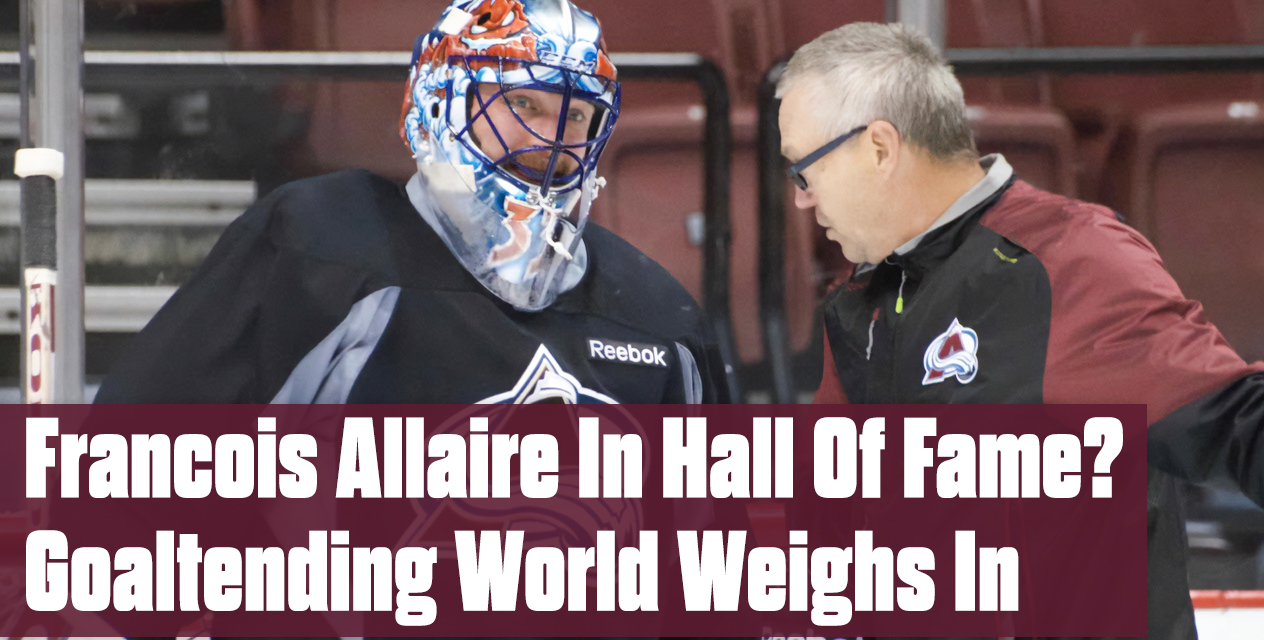
This article was originally published September 5, 2017
Francois Allaire was the first modern goaltending coach in the NHL, pioneering the position during a decade with the Montreal Canadiens.
Now, after announcing his retirement on Tuesday, the question is whether Allaire will be the first goalie coach inducted into the Hockey Hall of Fame.
If a career that included winning the Stanley Cup three times – two with Patrick Roy in Montreal in 1986 and 1993 and another with Jean-Sebastien Giguere and the Anaheim Ducks in 2007 – and coaching Roy to the Vezina Trophy three times isn’t a strong enough case, his peers and former pupils think Allaire’s role evolving both the goaltending and goaltending coach positions in the NHL should be.
“It is a no brainer and every goalie you talk to that had Frankie will tell you the same,” Giguere, who won the Conn Smythe Trophy as playoff MVP in 2003 before raising the Cup together four years later, told InGoal Magazine. “He was a pioneer and that’s why he deserves to be in the Hall of Fame.”
As closely as he will always be linked to Giguere and Roy, and their success integrating a butterfly system with the Canadiens that would quickly become the NHL standard, Allaire’s impact goes well beyond those relationships.
Just ask any young goalie growing up in Quebec in the late 1980s and early 1990s.
“Frankie was the most important person I’ve had playing hockey in my whole life,” Roberto Luongo, who worked with Allaire growing up and as a pro during the 2013 NHL lockout, wrote in a message to InGoal. “I wouldn’t be where I am today if it weren’t for him. He had that much of an effect on me growing up as a young teenager learning to play the position.”
“Frankie was the most important person I’ve had playing hockey in my whole life. I wouldn’t be where I am today if it weren’t for him. He had that much of an effect on me growing up as a young teenager learning to play the position.”
Perhaps just as importantly to the evolution of the position, Allaire also opened the door for goaltending coaches who had never played in the NHL. While there were goalie coaches in the NHL before Allaire, most were been-there, done-that former goalies offering someone to talk to and experience-based advice. Allaire, who began as an assistant with the Sherbrooke Canadiens in the American Hockey League in 1984, brought a modern technical approach to the position.
“Frankie gave credibility and showed the importance of a goalie coach,” said Mitch Korn, who started his goalie coaching career with the Buffalo Sabres in 1991.
Korn also stepped away from full-time coaching this season and is now working in a consulting role with the Washington Capitals. Many in the goalie community believe Korn will closely follow Allaire into the Hockey Hall of Fame on a list that should one day also include Allaire’s brother, Benoit, who has coached for the New York Rangers since 2005, and Ian Clark, who is the goalie coach of the Columbus Blue Jackets after stints with the Panthers and Vancouver Canucks and literally wrote the manual (several volumes actually, which the above coaches subscribed to) on butterfly goaltending.
It’s worth noting none of them played in the NHL and wondering whether they would have gotten the same opportunities to coach in the League without Francois Allaire paving the way.
“It was so hard breaking into the NHL in any capacity having not played in the NHL, and he was able to do that,” Korn said. “So I thank Frank for paving the way and opening doors that have given people like myself and others the opportunity.”
A little more than 30 years after Allaire broke that barrier, the number of NHL goaltending coaches who never played in the League (18) outnumbers those that did play (12), including Tampa Bay Lightning goalie coach Frantz Jean:
Francois Allaire not only changed the game but also changed yougn athletes and coaches lives by mentoring and personally encouraging them..
— Frantz Jean-PTG-TBL (@Protekgoalie) September 5, 2017
...while giving them a game plan that incorporated innovative technics... Thanks Frank for your mentorship and for being my role model...
— Frantz Jean-PTG-TBL (@Protekgoalie) September 5, 2017
In the crease, Allaire’s impact was just as impressive, especially in his native Montreal, where attendance at his annual summer camps often read like a who’s who of NHL goalies.
“We had a 10-day goalie camp before our season started at this time of year,” said Martin Biron, who played 508 games over 19 NHL seasons and is now working as an analyst with TSN in Canada and on Buffalo Sabres broadcasts. “I would be on the ice with Luongo, (Patrick) Lalime, (Mathieu) Garon, Giguere, Manny Fernandez, all those guys. It was very demanding but it was so important to us because we needed that reset every year before camp started.”
Those were just the names Biron rattled off the top of his head.
“He basically coached all of the French-Canadian goalies at some point,” said Giguere, who now works as an analyst for TVA Sports. “It would be pretty amazing to see the number of goalies he’s touched and to see what kind of careers these guys all had. It’s an impressive number and like Roberto says, besides my parents and my wife, Francois is the most important person I had in my hockey career, especially once I reached the professional level. He had such an incredible influence on me.”
Biron echoed those sentiments, which is interesting because not many might have otherwise pegged him as a prototypical Allaire disciple. Truth is, Biron didn’t see himself as one either early on.
“I was not a typical, Francois Allaire type goaltender when I grew up,” Biron said. “I was more the stand-up, kick-save type goalie that relied on his reflexes and athleticism.”
Biron spent a week at Allaire’s camp at age 15 and returned the following year, admitting he was still “reluctant.”
“I was like ‘ok this is all great but it’s not really my style,” Biron recalled. “But as I got older and then worked at the goalie school I realized this is not just a style. Goalies at the time were ‘oh you are butterfly, that means you have to go on your knees.’ No. His vision was the amount of work and the detailed work and the skating work and the positioning work that goalies need to do to implement a certain style at the end of it, so if you wanted to be a butterfly goalie and go down on your knees to make a save, great, but everything before — the movement, the squareness and all of that stuff we are stressing today – this was all being done in the 80s by Frank and I realized soon that this was something I really needed.”
“His vision was the amount of work and the detailed work and the skating work and the positioning work that goalies need to do to implement a certain style at the end of it, so if you wanted to be a butterfly goalie and go down on your knees to make a save, great, but everything before — the movement, the squareness and all of that stuff we are stressing today – this was all being done in the 80s by Frank…”
The turning point for Biron was being invited as a 19 year old to work as Allaire’s demo goalie for his annual two week camp in Switzerland before turning pro the following season.
“I am telling you that is probably the best thing I have ever done,” Biron said of the Switzerland camp, which also helped launch the NHL careers of Martin Gerber, Cristobal Huet and Jonas Hiller. “I spent two weeks with him and it set my views on things. I was on the ice six hours a day with him and it was amazing, and if it wasn’t for him and if it wasn’t for that, I don’t know that I would have been able to make it or be as successful because that laid down the strong foundation I needed.”
For Biron, who also credits Benoit Allaire for extending his career during his final four seasons with the Rangers, that foundation was the most important part of his work with Allaire. There were times, especially after a less than amicable split with the Toronto Maple Leafs, that Allaire’s methods were labeled as too rigid by some in the hockey world but just as he realized it wasn’t a “style” earlier in his career, Biron knew the “blocking” stereotypes that followed were misplaced.
“With Frankie and Benoit you have to surrender a little bit of that comfort level and really trust they are there for your benefit, that maybe some changes in your game are going to be important,” Biron said. “A lot of goalie coaches will say ‘I am not here to change your style, I’ll work with you’ and it’s true you don’t want to change somebody’s style but if Francois saw something that needed to be updated, that needed to be 21st century,you kind of have to give a little bit of that trust to be able to be better and that’s not always the most popular approach. It’s very effective when you allow it and I’ve seen goalies like Luongo, like Giguere allowing it but I’ve also seen some fighting it and that doesn’t get you anywhere.”
Giguere saw firsthand Allaire’s flexibility during his time with the Colorado Avalanche alongside Semyon Varlamov. While Giguere was often labeled a prototypical Allaire goalie, the more active Varlamov was viewed as anything but. Yet Varlamov was arguably the best goalie in the NHL in 2013-14, his first season under Allaire, losing out on the Vezina Trophy to Tuukka Rask.
“Everyone thinks of Frankie as a one-dimensional type of goalie coach but he’s not,” Giguere said. “He adjusts to the type of goalie he has. Some of the foundation he teaches are the same for every goalie, it doesn’t matter what type of goalie you want to be. If you want to stay up a little more, if you want to be butterfly, if you want to be a blocking style, some of the foundation is very simple technical things he teaches that can apply to any goalie in this league. Varly and I had totally different styles, totally different, but at the same time we worked, we did the same drills with Frankie and Frankie adjusted to him very well and Varly adjusted to Frankie very well and it was a great match between the two.”
Giguere is actually more impressed with Allaire’s ability to help less naturally-skilled goalies, pointing to himself, James Reimer in Toronto and Calvin Pickard in Colorado as examples.
“The amazing part was what he was able to do with probably average goalies and make them good NHL goalies,” Giguere said. “As long as you were willing to work, I had no doubt if you had a little bit of talent he would make you a good goalie.”
“The amazing part was what he was able to do with probably average goalies and make them good NHL goalies. As long as you were willing to work, I had no doubt if you had a little bit of talent he would make you a good goalie.”
If that isn’t enough when the Hockey Hall of Fame starts casting ballots – and the truth is Allaire could have been elected as a builder while he was still coaching – there’s always goaltending equipment. Allaire worked hand in hand with the father-son team of Patrick and Michel Lefevre, who now build equipment for CCM, to make sure modern butterfly goalies had gear that fit their style and was famous for finding ways to close any possible holes when they were on the ice.
“He had a huge influence on equipment and making sure equipment fit the style of the goalie,” Giguere said. “Yes, the equipment is probably a nightmare now for the NHL but it worked for the goalies and that’s what matters. You wouldn’t punish Jacques Lemaire because he invented the trap.”
Add it all up, and Biron agrees a Hall of Fame nod as a builder should be next for Allaire.
“The Hall of Fame is to recognize people that have contributed to game of hockey in a revolutionary way and Francois did that,” Biron said.
Become a Member to Read All the Exclusive Goaltending Content
We’re working hard to bring you the best exclusive goaltending content whether you play goal, you are a coach, a parent of a goaltender, or a fan of the greatest position in sports.
All InGoal Premium members enjoy an ad-free experience.
Already a member?
Comments
Let's talk goaltending!
We welcome your contribution to the comments on this and all articles at InGoal. We ask that you keep it positive and appropriate for all - this is a community of goaltenders and we're here for each other! See our comment policy for more information.




